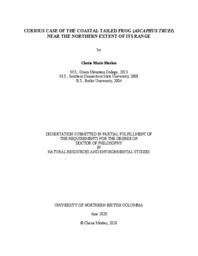Todd, Melissa
Person Preferred Name
Melissa Todd
Related Works
Content type
Digital Document
Description / Synopsis
Ascaphus truei, an ancient species of frog, migrated into British Columbia, Canada, following the last ice age. A. truei is of conservation interest because forestry practices, and the associated infrastructure, may reduce habitat quality. There is also concern that a warmer and drier climate will change the distribution and abundance of this species. I used two genetic methods, microsatellites and next-generation sequencing, to compare the genetic diversity of A. truei from the northern extent of its range in British Columbia, CA to southern Washington, USA. Both methods suggested a dramatic reduction in diversity across the northern portion of the species’ range. The phylogeography suggests a northern range expansion from a single refugium. I used DNA metabarcoding to compare the gut contents of larvae across three stream reaches and two development classes near the northern extent of A. truei's range. Gut contents differed between stream reach but did not differ among development class. Wetted width and ultimately stream volume may influence differences in gut content among stream reaches. I also quantified the relationship between an index of larvae density and environmental factors hypothesized to influence population density near the northern extent of the range. I assessed the segregation of larvae at various developmental stages. Wetted width and wetted depth correlated with differences in the abundance of larvae. Older developmental stages were captured in stream reaches with greater slopes than younger stages. Management should minimize modifications of stream structure, such as in-stream siltation due to road building. We should maintain habitat connectivity and gene flow to ensure the continued migration and adaptive capacity of A. truei.
Origin Information
Content type
Digital Document
Description / Synopsis
Pacific marten (Martes caurina) may benefit from invasive or non-native species that occur across some coastal areas of the Pacific Northwest. I used remote-camera trapping and stable-isotopes of carbon and nitrogen to infer resource-use strategies of marten on Haida Gwaii, British Columbia, Canada. Marten are more likely to be detected in 3 ha patches with less logging and optimal amounts of road and forest edge habitat, and areas close to marine shorelines and streams. Findings from bulk carbon and nitrogen stable-isotope analysis suggest that terrestrial fauna, including birds, deer, small mammals, and invertebrates, contribute the most to diet; marine invertebrates are the second-most important prey group. Marten consume salmon and berries seasonally, but these are a relatively minor component of the diet. Knowledge of habitat and diet ecology of this generalist, apex predator should be integrated into ecosystem-based management and conservation of the globally rare old-growth forests that remain relatively intact on Haida Gwaii.
Origin Information


